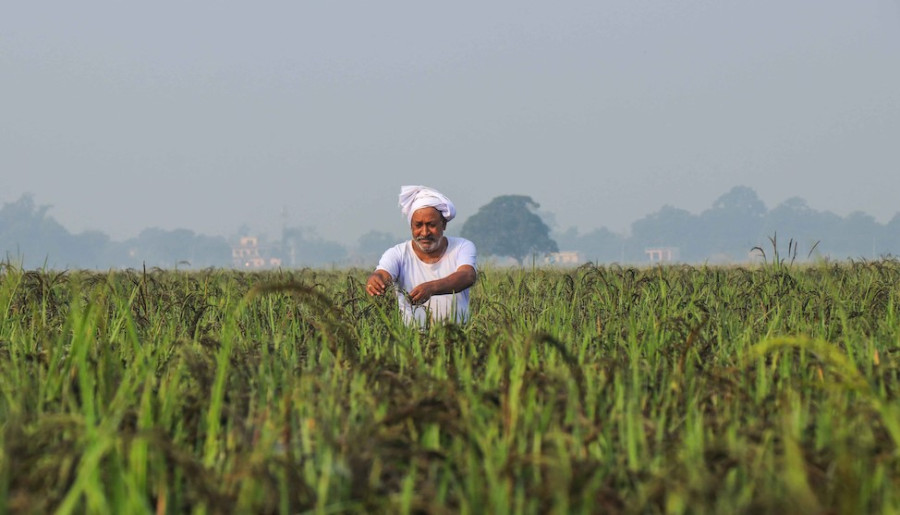Columns
Agriculture growth through investment
Sustained investment in the sector depends on commercialisation and technological advancements.
Pralhad Giri
Sustaining continuous economic growth in a country like Nepal necessitates the strengthening and efficient functioning of its real sectors, such as agriculture, tourism, water resources and the service sector. These sectors offer boundless opportunities for investment. However, the agricultural sector’s contribution to the economy has declined yearly. This sector earlier accounted for approximately one-third of Nepal’s gross domestic product (GDP) but is now facing a discouraging scenario regarding investment. In 2005, it contributed 36.64 percent of the GDP; by 2022, it had plummeted to 23 percent. Despite its immense potential, the lack of technical skill development and commercialisation highlights the need for investment opportunities in this domain.
While agriculture has provided livelihoods to many people, its potential as a crucial foundation for economic prosperity remains untapped due to ineffective business development strategies. Even when cultivated land serves subsistence purposes and contributes insignificantly to the national output, this limits investment prospects for the agricultural sector.
Increased obstacles
Banks often cite increased risk as the primary reason for the limited growth of agricultural investment. Low possibility of loan consumption and difficulties in debt recovery are some challenges. Currently, the central bank, Nepal Rastra Bank, has prioritised a directed loan programme for investment, clearly stipulating that loans should be formally granted to the productive sector. Failure to comply with these instructions may result in penalties. Banks exhibit indifference towards investing in the agricultural sector despite this directive, citing risk and concerns regarding credit consumption suitability. The annual budget and monetary policy align their objectives to focus on investing in the real sector, boosting domestic production, generating employment, curtailing imports and encouraging investments in small enterprises.
It is crucial to establish coordination between the banking sector, agricultural experts and technical skill development programmes to enhance the effectiveness of the agricultural credit programme. To elevate the income levels of farmers, the government has allocated subsidies to approximately Rs1.5 billion this year. Although these subsidies are intended for commercial agriculture and business projects, it’s unclear if they align with the intended objectives. One issue is selecting projects eligible for grants, which lacks a blueprint for on-site monitoring and evaluating their effectiveness. The government has directly subsidised the commercial production and marketing of agricultural products with comparative advantages.
However, determining which specific area or food item qualifies for these subsidies presents a challenge. The current distribution process doesn’t involve any needs assessment, implying that proposals have been made for farmers to engage in commercial dairy and meat-related businesses until the end of December. Comparatively, the effectiveness of agricultural loans from banks might be hindered within the same market where farmers are accustomed to subsidies. Furthermore, the influence of imitation remains prevalent in rural areas, where farmers eagerly pursue subsidies and even expect interest waivers, making it more challenging to repay loans in the long run even if they acquire it.
Promoting financial inclusion is crucial for fostering entrepreneurship in agriculture and facilitating commercial farming practices. It’s important to note that inclusivity is more than just a numbers game; it must be meaningful. This can be achieved by establishing coordination between the banking sector, commercial agriculture and business projects to provide farmers with practical knowledge about loan acquisition, loan utilisation, payment methods and transactions through bank accounts. This will enable farmers to gain insights into enhancing business efficiency, become familiar with banking practices, understand the role of the agricultural sector in the financial domain and explore opportunities for earning foreign currency through exporting agricultural goods.
There is a pressing need to align the agricultural budget allocated by the government with the banking system. Experts in the banking sector emphasise that sustained investment in the agricultural sector hinges on commercialisation and technological advancements. Unfortunately, the government has primarily focused on agricultural production, overlooking marketing strategies and the incorporation of technology. To ensure the longevity of investments, banks require the assurance of viable marketing channels, as it is only through such avenues that investment sustainability can be achieved.
Credit challenges
Farmers and potential agricultural entrepreneurs face numerous challenges when applying for bank loans. Many express grievances about irregular collection practices and the complicated loan disbursal process. Bank requirements such as land proximity to roads for a mortgage, business registration, village or local body recommendations, consent from neighbours and age limitations for mortgage owners or aspiring business owners pose further obstacles. The additional burden of business registration and the need for a detailed business plan deter young individuals. Furthermore, many young individuals reside abroad, and those in the country often have low literacy levels and little interest in understanding the loan process.
A notable challenge regarding agricultural credit is the potential for misuse or misallocation of funds. With the surge in real estate and stock trading, individuals from various backgrounds, including village teachers, farmers and porters, have become cautious about investing in shares. According to bank employees, a significant portion of the agricultural loans is being diverted towards unproductive sectors such as land speculation, real estate purchases, stocks and precious metals like gold and silver. Despite the regular non-repayment of loans allocated to unproductive areas, banks seem to be turning a blind eye to this issue. Nonetheless, this is not the sole concern. Banks must prioritise planning and income levels when investing in agricultural loans rather than relying solely on immovable property as collateral. They should avoid geographical and facility-based discrimination. The unified directive issued by the Nepal Rastra Bank emphasises the consideration of collateral based on movable and immovable assets, as well as group or project-based mortgages. Banks can specify mortgage or project requirements by assessing the market conditions within their credit-policy guidelines.
The government’s initiatives to promote youth engagement in agricultural businesses have encountered several obstacles, hindering their desired outcomes. Limited access to financial institutions for farmers, complexities surrounding mortgages, intricate loan procedures and the reluctance of banks to consider projects as collateral has contributed to the failure to achieve the intended milestones. Although a 4 percent interest rate subsidy was introduced to facilitate loans for agricultural ventures at 6 percent, many youths express dissatisfaction with this provision. Similarly, the 75 percent premium discount for agriculture and livestock insurance has not fostered a favourable environment. Despite formulating policies and regulations, implementing them without thoroughly evaluating their practical feasibility has resulted in ineffective outcomes.
If investments are directed towards unproductive sectors, the overall focus shifts away from the real sectors of the economy. This growing inclination towards unproductive sectors by borrowers and lenders hinders progress in achieving food security, poverty alleviation and job creation. From a recovery standpoint, it’s crucial to prioritise investments in sectors like agriculture that can contribute to sustainable economic growth.




 7.12°C Kathmandu
7.12°C Kathmandu















